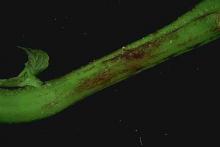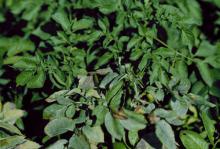Cause The fungus, Golovinomyces orontii (formerly Erysiphe cichoracearum; anamorph Euoidium violae), is reported throughout the world on a wide range of hosts, but the strain on potatoes is a distinct physiologic race. Row-irrigated potatoes are more likely to show infection than sprinkler-irrigated.
Symptoms Powdery mildew is not always as noticeable on potatoes as on other plants. It first appears on potatoes as brown lesions of various sizes on stems and petioles. Lesions coalesce to form short streaks or stippled patches. The white powdery coating typical of powdery mildews on most other hosts frequently does not develop on potatoes, but if the air is moist, diseased leaves eventually may be covered by it.
Leaves and stems are killed, and only the tip of the plant may remain green. In severe cases, vines collapse. Infection and vine collapse may be over large areas of the field. Late in the season, small black specks may develop in the powdery growth. These are chasmothecia, the overwintering fungal bodies.
Cultural control
- Some varieties are more susceptible than others. In general, varieties such as Pontiac are more severely affected than the russet varieties. The most susceptible of the common varieties is Norgold followed by Kennebec and then Russet Burbank.
- There is some evidence that early planting reduces loss.
Chemical control Most often this disease does not cause enough damage to warrant fungicide use.
- Amistar Top (Group 11 + 3) at 8 to 14 fl oz/A on a 7- to 14-day interval. Do not make more than two (2) sequential applications before alternating to a labeled fungicide with a different mode of action. Preharvest interval is 14 days. 12-hr reentry.
- Badge SC (Group M1) at 1 to 4 pints/A on 5-day intervals. Preharvest interval is 0 days. 48-hr reentry.
- Bicarbonates are registered to control powdery mildew. Thorough coverage is essential.
- Carb-O-Nator at 2.5 to 5 lb/100 gal of water on 5- to 14-day intervals, depending on disease pressure. Preharvest interval is zero (0) days for all listed crops. 4-hr reentry. O
- MilStop SP at 2 to 5 lb/A on 7- to 14-day intervals. Oregon and Washington only. Can be applied up to and including the day of harvest. 1-hr reentry. O
- Vacres at 2.5 to 5 lb/A on 7- to 14-day intervals. Preharvest interval is zero (0) days. 4-hr reentry.
- Carboxamide (Group 7) formulations are registered for use. Do not make more than two (2) sequential applications before alternating to a labeled fungicide with a different mode of action (non-Group 7).
- Fontelis (SLN OR-220004; SLN ID-220007; SLN WA-220003) at 10 to 24 fl oz/A on 7- to 14-day intervals. Preharvest interval is 7 days. 12-hr reentry.
- Vertisan at 14 to 24 fl oz/A on 7- to 14-day intervals. Preharvest interval is 7 days. 12-hr reentry.
- JMS Stylet Oil at 3 to 6 quarts/100 gal water. Do not spray if temperature is below 50°F, above 90°F or when plants are wet or under heat or moisture stress. 4-hr reentry. O
- Luna Tranquility (Group 7 + 9) at 8 to 12 fl oz/A on 7- to 14-day intervals. Do not make more than two (2) applications before alternating to a fungicide in different FRAC groups (non-Group 7 and non-Group 9). Preharvest interval is 7 days. 12-hr reentry.
- Miravis Prime (Group 7 + 12) at 9.2 to 11.4 fl oz/A on 7- to 14-day intervals. Do not make more than two (2) sequential applications before alternating to a labeled fungicide with a different mode of action. Preharvest interval is 14 days. 12-hr reentry.
- Revus Top (Group 3 + 40) at 5.5 to 7 fl oz/A on 7- to 10-day intervals. Do not make more than two (2) sequential applications before alternating to a labeled fungicide with a different mode of action. Preharvest interval is 14 days. 12-hr reentry.
- Strobilurin fungicides (Group 11) are labeled for use. Do not make more than one (1) application of a Group 11 fungicide before alternating to a labeled fungicide with a different mode of action.
- Quadris Flowable at 6 to 15.5 fl oz/A on 7- to 14-day intervals. Preharvest interval is 14 days. 4-hr reentry.
- Quadris Opti at 1.6 pints/A or Quadris Top at 8 to 14 fl oz/A on 7- to 14-day intervals. Preharvest interval is 14 days. 12-hr reentry.
- Sulfur formulations are registered for potato. Sulfur is fungitoxic in its vapor phase and, therefore, is effective only when air temperatures promote volatilization. Sulfur volatilizes above 65°F but becomes phytotoxic above 95°F. Using it above 85°F is not recommended. Although sulfur reduces sporulation of established infections, it is primarily a protectant and must be applied before infection. Do not allow spray drift to sensitive plants (spinach, etc.). Do not use within 2 weeks of an oil treatment.
- Microthiol Disperss at 5 lb/A. Do not apply if temperature will exceed 90°F within 3 days after application. 24-hr reentry. O
- Sulfur 6 Flowable at 3 to 4 pints/A. 24-hr reentry.
Biological control Efficacy in the Pacific Northwest is unknown.
- Double Nickel LC at 1 to 6 quarts/A on 3- to 10-day intervals. Can be applied the day of harvest. 4-hr reentry. O
- Ecoswing at 1.5 to 2 pints/A. Preharvest interval is 0 days. 4-hr reentry. O
- Romeo at 0.45 to 0.68 lb/A on 7- to 10-day intervals starting prior to infection. Preharvest interval is 0 days. 4-hr reentry. O
- Sonata at 2 to 4 quarts/A on 7- to 14-day intervals for disease suppression. Can be applied up to and on the day of harvest. 4-hr reentry. O



